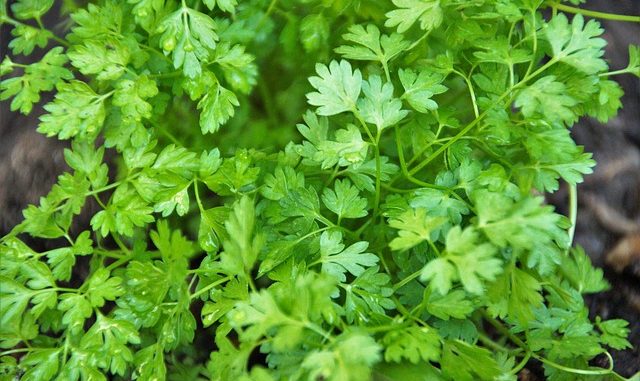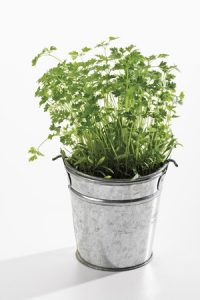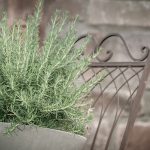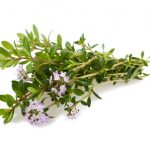
Chervil (Anthriscus cerefolium) is one of the original four traditional French ‘fines herbes’ which along with tarragon, parsley and chives are mixed and blended for haute cuisine.
Chervil, with its fine cut dark green leaves has a dainty, ferny feel to the leaf possessed of a mild, sweet aniseed flavour. The plant grows to between 20 cm and 40 cm. The flowers are small, pretty umbels of white flowers which are really loved by nectar feeding insects. It looks a bit like a small version of cow parsley or of herb parsley which is one of the common names for French parsley. It is in the same family.

Has to be grown as an annual although it has a biennial habit and almost grows as a perennial.
It is an evergreen which really doesn’t survive our coldest winters. If you sow all year round and keep some in a pot for overwintering in the greenhouse it is possible to have it literally all year round where it can be picked very fresh.
The crop is in the parsley family and prefers a partially wet, slightly shady or sunny spot. we grow it in the shade of other vegetable plants like runner beans so that it doesn’t dry out. Unfortunately, full sun causes it to dry out far too quickly and it will bolt. If it does bolt, we leave it in the garden to seed like parsley and this will just seed itself around the vegetable patch.
The plant needs to be watered and fed with a nitrogen-rich fertiliser on a periodic and regular basis. It is the leaves that we seek so harvest regularly to encourage fresher leaves to form.
Uses
Chervil has a subtle taste, which is a blend of mint, parsley and anise. It is best added to dishes either fresh or dried at the end of cooking because flavour tends to disappear when it is overcooked.
It is regularly added to poultry as part of a stuffing, especially chicken, to fish and various vegetables and salads to release its delicious bouquet. Try it with eggs too and with other seafood, soups and sauces. we have frozen it into ice-cubes and dropped them into dishes as required or to use in herb butter for steak. the leaves are picked fresh and dried very slowly in a cool oven or dehydrator.
Sowing Seed
Seed is sown in spring but regular sowings are encouraged so that it can be harvested into winter. Keep on sowing into August. Avoid sowing in hot weather.
Sow at 1/2in. deep in drills which are straight depressions in the soil.
It is best started in modules before being transplanted to larger pots once the seedlings reach 8 cm. In this case sow two seeds per module. When in trays cover with sieved compost or vermiculite and keep in a cool, shady place but not in a greenhouse or polytunnel. Water well and cover with the trays with a propagator lid or polythene bag. Seedlings will then develop which is 6 to 8 weeks following the sowing when the leaves can then be harvested.
When sowing in early spring , use a heated propagator set at 21 Centigrade or 70 Fahrenheit to get seeds off. water thoroughly when parts of the tray start to dry out. Germination takes place in 10 days minimum but 21 days is more usual depending on the time of year. You need to be patient !
Outside sowings will need regular watering. If you sow early in the season just cover with a plastic cloche to protect the plants and keep them in good condition for harvesting.
Pot grown sowings probably do best in the United Kingdom although it can be grown as part of a mixed salad. It needs a good depth in open ground because it has a long root tap system.
In the soil, thin your seedlings in stages to 25cm (10in.) apart, using the thinnings in cooking and when thinning try not to disturb the remaining plants. In trays, thin to one plant per cell as soon as the plants are large enough to handle.
Continued Growth And Growing On
Harden off plants which were started inside for a week to acclimatise them to life in the vegetable patch. Plant out into their final place i well-drained soil, taking care to not disturb the roots an more than necessary. Water in well and keep watering until the plants are established. Mulching really helps here because it retains moisture around the roots and also reduces the chance of bolting.
The plant is best grown amongst other crops to take advantage of the low light between plants.
Water regularly if the plant is grown on the patio or even indoors as conditions are always dried indoors then outside. It needs to be watered regularly to keep it moist. The container can be moved to a sheltered position so it receives low light levels during winter months.
If it bolts, just keep some flowers to set seed as they will freely then grow the following season. You can always shear off the flowers and let the plant continue producing fresh leaves. See our notes below on harvesting.
Issues With Chervil
Greenfly is an issue with open growing. They cause leaf distortion and discolouration as with all plants when they feed. A fatty acid spray, liquid soap and lots of ladybirds will help keep the numbers down. Otherwise use a strong but not fierce spray of water which soon disperses them.
Harvesting
Treat the leaves as a cut-and-come again crop irrespective of where the plant is growing. The leaves should be snipped away from the main stem using a small pair of scissors. The leaves are not ideal dried given that lose their delicate aroma. Keep the leaves in the refrigerator for up to a week but they lose the aniseed flavour slightly. The leaves probably need to be washed before use although it is possible to lose some of this flavour.



Leave a Reply